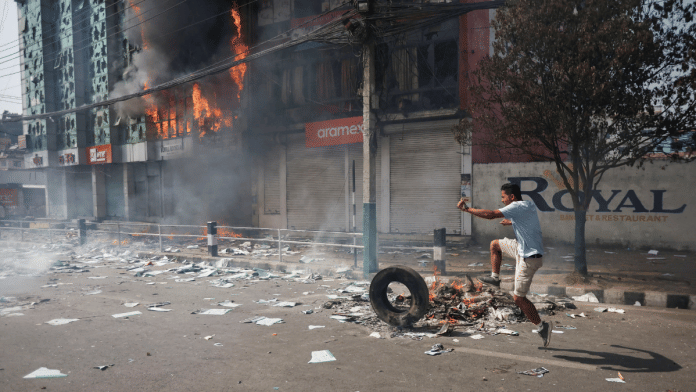New Delhi: India’s next-door neighbour Nepal is on the churn, as the growing public frustration with the government has sparked calls for return of the monarchy.
On Friday, curfew was imposed in parts of Kathmandu, The Himalayan Times reported, after two persons, including a TV cameraman, were killed in clashes between the pro-monarchy demonstrators and the police. Prime Minister K.P. Sharma Oli too convened an emergency cabinet meeting late Friday.
Led by the Rastriya Prajatantra Party (RPP) of Kamal Thapa and the Citizens’ Campaign headed by Durga Prasai, protesters waving Nepal’s national flag marched towards the parliament building in central Kathmandu. Their demand: the reinstatement of a constitutional monarchy under Gyanendra Shah, the last king of Nepal, and the return to a Hindu state—a direct challenge to the secular republic established in 2008.
Friday’s protest comes weeks after an estimated 10,000 people flooded Kathmandu airport to greet Gyanendra on his return from a private trip, shouting, ‘Come back king, save the country. We want monarchy.’
The irony is hard to miss. Gyanendra became king in 2001 after a royal massacre wiped out his brother Birendra and much of the royal family. Initially a ceremonial monarch, he seized absolute power in 2005, dissolving parliament, jailing critics, and imposing military rule to fight Maoist rebels. Mass protests forced him to relinquish power in 2006. Two years later, Nepal abolished the monarchy, ending 240 years of royal rule and declaring itself a secular republic.
Now, the Committee for the Restoration of Monarchy, which organised the protests, has called for a “constitutional monarchy with a parental role above politics” — a concept echoed by some religious groups and citizens demanding a Hindu kingdom.
But these protests are not sudden. Both RPP, led by former deputy prime minister Kamal Thapa, and the Citizens’ Campaign, headed by entrepreneur Durga Prasai, had previously organised major demonstrations, including the large rally in Kathmandu in November 2023, calling for the reinstatement of the monarchy.
“Such sentiment and protests have taken place in the past as well. At the ideational level, the monarchy supporters in Nepal believe that there is no political stability in the country which was the case under monarchy,” Raj Kumar Sharma, senior fellow, NatStrat and MoFA visiting fellow, NCCU, Taiwan told ThePrint.
Also Read: King without a kingdom—why Gyanendra’s return has sparked monarchy chatter in Nepal
Nepal’s political shifts
Once a deeply revered institution, Nepal’s monarchy was dismantled after years of civil war and protest. The decision came in 2008, following a peace agreement that ended a decade-long Maoist insurgency which claimed 17,000 lives. In the deal’s wake, a specially elected assembly declared Nepal a secular, federal republic, formally ending the Shah dynasty’s 239-year reign.
Since then, the country has cycled through 14 governments in 16 years. Successive coalition governments have collapsed like a house of cards. The unrest is only a surface expression of deeper political and economic anxieties.
“Political instability has led to economic stagnation and problems like corruption, lack of employment opportunities, and misgovernance. Nepali youths have been migrating to other countries looking for greener pastures,” Sharma said.
Madhav Kumar, a senior leader of the ruling coalition and former prime minister, told CNN-News18 that these protests involve only a few thousand people, and the numbers are being exaggerated, adding that all major parties stand united against the monarchy’s revival.
Kumar directly accused Durga Prasai — once a marginal political figure — of using the monarchy as a shield against growing legal trouble. Prasai, the founder of BMC Medical College, allegedly owes over 12 billion Nepalese rupees to the central bank, he said.
‘Return’ of the king amid political, economic crises
Meanwhile, Gyanendra, in a rare video address on 18 February—Nepal’s Democracy Day—offered sharp criticisms of the current political order. He decried “exclusionary politics,” warned of “a country losing its soul,” and lamented Nepal’s growing debt, broken institutions, and the exodus of its youth.
Gyanendra’s resurgence has thrown Nepal’s major parties off balance. Prime Minister K.P. Sharma Oli, leader of the Unified Marxist-Leninist party (UML), challenged the ex-king to “stop playing hide and seek” and form a party if he wishes to test his popularity at the ballot box, The Kathmandu Post reported.
Former Maoist leader Pushpa Kamal Dahal aka Prachanda echoed the call—framing Gyanendra’s rise as an affront to the republic born from their revolution.
Meanwhile, Nepal’s economy has sputtered in recent years. Nepal saw 4% growth in 2024, driven by tourism, remittances, and agriculture exports, but the World Bank warns of weak investment and revenue. Despite gains—like a tourism rebound and a boost in hydropower—its economy remains fragile, hampered by political instability and external dependence.
Caught in the tussle of India, China, and Uthe .S. influence, the country also faces mounting uncertainty. India remains Nepal’s top trade partner, with $8.85 billion in bilateral trade in 2023. While China has invested heavily through the Belt and Road Initiative (BRI), debt concerns have made Kathmandu wary. U.S. aid, including a $500 million MCC compact, faces uncertainty. As frustrations rise, Nepalis seem to be looking to the past for solutions.
“These protests are a warning sign for the current political system and its leaders in Nepal. Further failure on their part to address basic public grievances like economic development could challenge the nature of the existing political and social contract between the people and the leaders,” Sharma said.
(Edited by Tony Rai)
Also Read: How Nepal ‘evolved as a sullen neighbour when it should be the friendliest of all’







Nepal’s road to democracy has proved very rocky in the initial phase. Roughly one PM a year. But a return to absolute monarchy is not an option that should even be thought of.